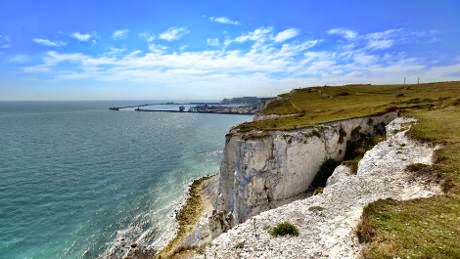A – Z OF THE UNITED KINGDOM
W
is for The White Cliffs of Dover
Kent

Today we travel to Kent
To
The White Cliffs of Dover
 |
|
View of White Cliffs of Dover
|
The White Cliffs of Dover form
part of the English coastline facing the Strait of Dover and France. They are part of the North Downs formation
with a striking façade made up of chalk accentuated by streaks of black flint
and reach up to 350 feet (110m). The
cliffs spread out East and West from the town of Dover in the county of Kent
which is a very important English port.
The cliffs themselves were formed at the same time as the Straits of Dover,
by ice-age floods.
I live not
far from this great symbol of Britain (40 minutes drive away) and have known
them all my life. I have seen them from
France as I returned home from holiday on a ferry. I have walked along the cliff tops. I have seen France from them (on a good day
with the right weather conditions) in the distance and I have also sat on Cap Gris Nez, in France and seen the White
Cliffs from there.
Dover was the primary route to the continent before the advent of air travel
and the white line of cliffs formed the first or last sight of England for
travellers.
The White Cliffs are at one end of the Kent Downs designated an Area of
Outstanding Natural Beauty.
From France:
 |
|
The cliffs seen across the
channel from Cap Gris Nez, France
|
The cliff face continues to weather at an average
rate of 1 centimetre (0.39 in) per year, although occasionally large
pieces will fall. In 2001 a large chunk of the edge, as large as a football
pitch, fell into the channel. A further large section collapsed into the
English Channel on 15 March 2012.
Visitors are, therefore, urged to remain well away from the cliff edge.
 |
|
Close up of the
cliffs from the walk along the ridge
Wikimedia Commons
|
South Foreland Lighthouse above
the cliffs at Dover
 |
|
South Foreland lighthouse above the
cliffs at Dover
|
South Foreland Lighthouse is a Victorian lighthouse in St. Margaret’s
Bay, Dover and was used to warn ships approaching the nearby Goodwin
Sands. It went out of service in 1988
and is now owned by the National Trust.
A lighthouse has stood on this site since 1730 and during most of this
time was manned by the Knott family of lighthouse keepers.
I have climbed up this lighthouse and stood in wonder
(and wind) viewing the aspect from the cliff top.
The best way to see the cliffs is to take a walk
along the coastal path towards South Foreland Lighthouse. You’ll get a great
view of the cliffs and also see the chalk grassland that’s home to so many
unusual plants and insects like the chalkhill blue butterfly and the pyramidal
orchid.
 |
|
https://www.nationaltrust.org.uk/white-cliffs-dover/ |
 |
|
Watching the ferries from the Port of Dover
|
 |
|
Watching the ferries from the Port of Dover
|
 |
|
https://www.nationaltrust.org.uk/white-cliffs-dover/ |
During the summer of 1940 reporters gathered at
Shakespeare Cliff to watch aerial dogfights between German and British aircraft
during the Battle of Britain.
Vera Lynne sung the famous song The White Cliffs
of Dover
There'll be blue birds
over
The white cliffs of Dover,
Tomorrow, just you wait and see.
The white cliffs of Dover,
Tomorrow, just you wait and see.
There'll be love and
laughter
And peace ever after
Tomorrow, when the world is free.
And peace ever after
Tomorrow, when the world is free.
The shepherd will tend
his sheep,
The valley will bloom again
And Jimmy will go to sleep,
In his own little room again.
The valley will bloom again
And Jimmy will go to sleep,
In his own little room again.
There'll be blue birds
over
The white cliffs of Dover,
Tomorrow, just you wait and see.
The white cliffs of Dover,
Tomorrow, just you wait and see.
Words - Nat Burton
Melody - Walter Kent
Published - 1941
Melody - Walter Kent
Published - 1941
I
sit quietly on top of a cliff
The
wind curling my hair to a quiff
The
smell of the sea wafts up from below
The
sound of the seagulls as they squawk and crow
I
gaze across an expanse no more than 20 miles distance
I
wonder if my life would have been different in that instance
Perhaps
I should have said yes to my beau
All
those long years ago
Maybe
he would have survived
With
my love to keep him alive
He
gave his life so others might be free
As
his plane came down over the sea
 |
|
http://ww2today.com/20th-august-1940-never-in-the-field-of-human-conflict
|



Your description of the cliffs as the first thing you see when returning from France reminds me of how people describe seeing the Statue of Liberty in New York.
ReplyDeleteYour poem brings sadness to all the beauty of the cliffs -- a fact of life though.
Thanks for an excellent tour of the White Cliffs of Dover! My friend told me they aren't always so white, but still are impressive. One day I hope to see them, perhaps on my next trip to France. (in the future) And thanks for stopping by the WEP entry at my 21st century blog. I'm doing the A to Z on my Rainforest blog.
ReplyDeleteHave a great Sunday.
They are beautiful - a wonderful national symbol. I've never seen them in person. Someday.
ReplyDeleteI've always wanted to visit the White Cliffs of Dover. I didn't know you could see them from France!
ReplyDelete